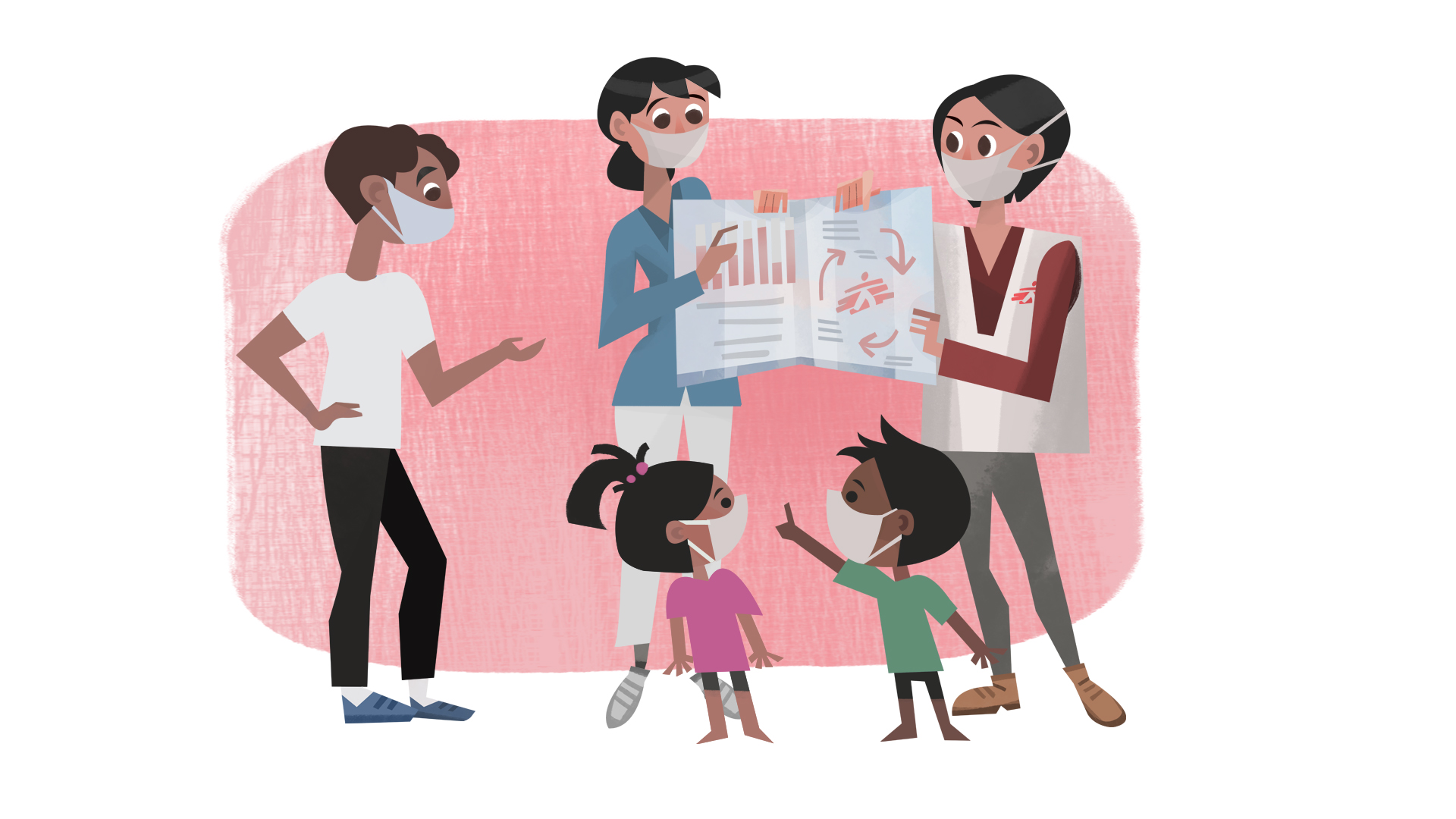
Breadcrumb
- Home
- Infectious But Not Invincible
- Measles
Measles: Resurgence Of A Preventable Disease
The first detailed description of measles was provided by Persian scholar Rhazès in the 10th century. Prior to that, the disease has mostly been confused with smallpox.
The 20th century saw significant advances on measles research in the United States. In 1954, American biologist and Nobel Prize winner John Enders succeeded in isolating the virus which led to the development of the first vaccine, Rubeovax, in 1963.
In 1971, Attenuvax, a combination of attenuated measles, mumps and German measles, was developed. It was the first vaccine to be injectable in one single dose, followed by a booster.
The vaccine contributed to a considerable reduction in the number of deaths due to measles. In 1980, when vaccination was not yet widespread, measles caused 2.6 million deaths worldwide. In contrast, 2014 to 2016 saw historic lows in measles cases and deaths due to global routine immunisations. However, in 2019, measles claimed an estimated 207,500 lives, which according to a publication of the World Health Organisation and US Centres for Disease Control and Prevention, is due to vaccination failures.
How is Doctors Without Borders Responding to Measles?

Measles vaccination campaigns (and treatment during outbreaks) are important for Doctors Without Borders. There are vaccination campaigns every year, in a wide range of countries such as the Democratic Republic of Congo and Central African Republic. Doctors Without Borders also works to address measles outbreaks in Chad, Niger, Nigeria and Bangladesh. Doctors Without Borders has vaccinated some 28 million children against measles since 2006. Outbreaks are fuelled by weak public vaccination systems and low vaccination coverage, including in areas of conflict and among high numbers of people living in close quarters, such as refugee camps or slums.

Most of Doctors Without Borders’ research on measles are mortality studies, and vaccination coverage studies. All mass vaccination campaigns should in theory be followed by a vaccination coverage survey, to measure the result of the campaigns.
Some of these surveys are published by Epicentre. Some other papers are available at Doctors Without Borders’ Field Research.

Doctors Without Borders’ advocacy on measles is mainly about access to vaccines (and funding). Doctors Without Borders works with governments to ensure there is sufficient supply of vaccines, and that these are available at reasonable prices. On the patient end, Doctors Without Borders has measles vaccination campaigns for people in need.
Doctors Without Borders’ Access Campaign, with the intersectional Vaccine Working Group, is also working on pushing GAVI Alliance to align its policies with WHO recommendations, allowing countries to vaccinate children beyond 12 months and to have the necessary vaccines for this policy.
REAL PEOPLE, REAL STORIES
Nurata’s nine-month-old daughter Nur Salima had a fever for about six days before she received treatment at Kutupalong hospital in Cox's Bazar, Bangladesh. Nurse Younus explains that baby Nur Salima was barely conscious when she arrived at the emergency room.
Severe respiratory infections and difficulty in breathing are common complications with critical measles cases. Doctors Without Borders’ doctor Nowshad Alam Kanan describes how young children arrive at the clinic, gasping for breath. “It’s just like suffocating,” he says.

© Tariq Adnan/MSF
The doctors gave the baby oxygen to help her breathe, and antibiotics to fight secondary infections.
After five days in the isolation ward, Nur Salima improved and was finally strong enough to be discharged. Having nursed her back to health, nurse Younus is delighted. "The feeling of watching a patient survive is indescribable” he says, overjoyed.
- What is measles?

Measles is a viral respiratory disease that is highly contagious and mostly affects young children. It can lead to death but is highly preventable with vaccines developed back in the 1960s which are still effective today.
- Is measles similar to mumps or rubella?

Measles, mumps, and rubella are different diseases caused by different viruses. However, they have similar characteristics.
Measles starts with a fever, cough, runny nose, conjunctivitis (pink eye), and a red, pinpoint rash that starts on the face and spreads to the rest of the body. If the virus infects the lungs, it can cause pneumonia. Measles in older children can lead to inflammation of the brain, called encephalitis, which can cause seizures and brain damage.
The mumps virus usually causes swelling in glands just below the ears, giving the appearance of chipmunk cheeks. Before the vaccine, mumps was the most common cause of both meningitis (inflammation of the lining of the brain and spinal cord) and acquired deafness. In men, mumps can infect the testicles, which can lead to infertility.
Rubella is also known as German measles. It can cause a mild rash on the face, swelling of glands behind the ears, and in some cases, swelling of the small joints and low-grade fever. Most children recover quickly with no lasting effects. But if a pregnant woman gets rubella, it can be devastating. If the infection happens during the first trimester of pregnancy, there's at least 20% chance the child will have a birth defect such as blindness, deafness, a heart defect, or intellectual disabilities.
- How is measles transmitted?

An airborne disease, the measles virus is spread by coughing, sneezing and saliva.
These spread to surfaces and the virus remains transmissible for up to two hours, removing the need for direct person-to-person contact.
For 10 to 14 days after the start of infection, the disease exhibits no symptoms.
- Can measles kill you?

Measles can be very severe or even fatal for children under five, especially those living in crowded conditions or who are malnourished or HIV positive. Less common but more dangerous is encephalitis a brain inflammation that occurs in one in every 1,000 cases. It is the complications that can be fatal, especially in children aged five and below.
- What does measles do to your body?

A hostile intruder, the virus lodges in the respiratory tract, multiplies, and then enters the bloodstream where it can reach the body's organs: the spleen, lymph nodes, lungs, and liver. This is when the symptoms start: high fever, runny nose, cough, conjunctivitis and sometimes diarrhoea. This is also when the infected child is most contagious.
A distinctive sign of measles is Koplick’s spots, which are small spots that appear inside the mouth.
Then a rash breaks out. Within four days, small spots appear, initially on the face before spreading to the rest of the body. The spots look like tiny grains of white sand, each surrounded by a red ring.The rash then fades three to four days after its appearance, and the skin does not always peel off as it usually does after a rash.
Most children will have uncomplicated measles, and will experience tiredness or fatigue for about ten days before recovering. Around 10% to 40% will have complications such as ear infection, pneumonia, or other respiratory infections.
- When should you meet the doctor or seek treatment?

You should also see your doctor if you've been in close contact with someone who has measles, and you have not been fully vaccinated; full vaccination means having completed two doses of the MMR vaccine. Another reason to see your doctor after close contact with someone who infected is if you haven't had the infection before—even if you don't have any symptoms.
- Who is most prone to measles?

Those in low-income countries, especially children, are at highest risk for measles. Combined with malnutrition or malaria, its effects can be devastating.
In these countries, measles mortality usually fluctuates between 3% and 6%, but can be as high as 30% in refugee camps and remote communities.
- How can you prevent or treat measles?

There is no specific treatment for measles. The focus is on preventing complications and treating symptoms. Paracetamol is administered for headaches, ointment for eye infections. Antibiotics are only necessary if the patient has a secondary bacterial infection such as pneumonia or an ear infection.
The best way to combat measles is through vaccination with the combined measles, mumps and rubella (MMR) vaccine. To prevent epidemics, it is crucial for vaccination coverage, or the vaccination level of a population at any given point in time, to be over 90% in order to reduce or eliminate the number of carriers and stop transmission of the virus. Through this, communities achieve what is referred to as herd immunity.
- Can I still get measles after medication/treatment?

A person who has recovered from measles will have antibodies that will make him or her immune from the virus. Vaccination can likewise protect a person from measles. It is recommended for all children to receive two doses of the MMR vaccine to increase vaccination protection up to 98%.
TEN QUESTIONS ABOUT MEASLES
WHAT ELSE SHOULD YOU KNOW

Measles is highly contagious. It has a ‘basic reproduction ratio’ (also called R0) of 12-18. This means that one infected person can infect 12 to 18 other people.